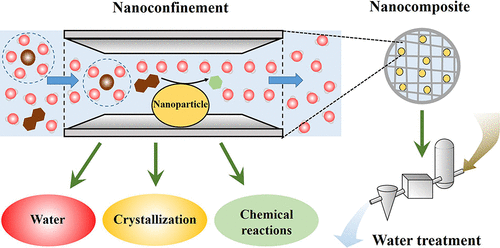当前位置:
X-MOL 学术
›
Environ. Sci. Technol.
›
论文详情
Our official English website, www.x-mol.net, welcomes your feedback! (Note: you will need to create a separate account there.)
Nanoconfinement-Mediated Water Treatment: From Fundamental to Application.
Environmental Science & Technology ( IF 11.4 ) Pub Date : 2020-06-08 , DOI: 10.1021/acs.est.0c01065 Jieshu Qian 1, 2 , Xiang Gao 1 , Bingcai Pan 1, 3
Environmental Science & Technology ( IF 11.4 ) Pub Date : 2020-06-08 , DOI: 10.1021/acs.est.0c01065 Jieshu Qian 1, 2 , Xiang Gao 1 , Bingcai Pan 1, 3
Affiliation

|
Safe and clean water is of pivotal importance to all living species and the ecosystem on earth. However, the accelerating economy and industrialization of mankind generate water pollutants with much larger quantity and higher complexity than ever before, challenging the efficacy of traditional water treatment technologies. The flourishing researches on nanomaterials and nanotechnologies in the past decade have generated new understandings on many fundamental processes and brought revolutionary upgrades to various traditional technologies in almost all areas, including water treatment. An indispensable step toward the real application of nanomaterials in water treatment is to confine them in large processable substrate to address various inherent issues, such as spontaneous aggregation, difficult operation and potential environmental risks. Strikingly, when the size of the spatial restriction provided by the substrate is on the order of only one or several nanometers, referred to as nanoconfinement, the phase behavior of matter and the energy diagram of a chemical reaction could be utterly changed. Nevertheless, the relationship between such changes under nanoconfinement and their implications for water treatment is rarely elucidated systematically. In this Critical Review, we will briefly summarize the current state-of-the-art of the nanomaterials, as well as the nanoconfined analogues (i.e., nanocomposites) developed for water treatment. Afterward, we will put emphasis on the effects of nanoconfinement from three aspects, that is, on the structure and behavior of water molecules, on the formation (e.g., crystallization) of confined nanomaterials, and on the nanoenabled chemical reactions. For each aspect, we will build the correlation between the nanoconfinement effects and the current studies for water treatment. More importantly, we will make proposals for future studies based on the missing links between some of the nanoconfinement effects and the water treatment technologies. Through this Critical Review, we aim to raise the research attention on using nanoconfinement as a fundamental guide or even tool to advance water treatment technologies.
中文翻译:

纳米约束介导的水处理:从基础到应用。
安全和清洁的水对地球上所有生物和生态系统至关重要。然而,人类经济的加速发展和工业化产生的水污染物的数量和复杂性都比以往任何时候都要大得多,这挑战了传统水处理技术的功效。在过去的十年中,对纳米材料和纳米技术的蓬勃发展研究对许多基本过程产生了新的认识,并在包括水处理在内的几乎所有领域为各种传统技术带来了革命性的升级。纳米材料在水处理中的实际应用中必不可少的步骤是将纳米材料限制在可加工的大型基材中,以解决各种固有问题,例如自发聚集,操作困难和潜在的环境风险。令人惊讶地,当由基板提供的空间限制的大小仅在一个或几个纳米的数量级上时,被称为纳米约束,物质的相行为和化学反应的能图可以完全改变。然而,很少系统地阐明纳米约束下的这种变化及其对水处理的影响之间的关系。在本重要评论中,我们将简要概述纳米材料的最新技术,以及为水处理而开发的纳米受限类似物(即纳米复合材料)。然后,我们将从三个方面着重于纳米约束的影响,即水分子的结构和行为,受限纳米材料的形成(例如结晶),以及纳米化学反应。对于每个方面,我们将建立纳米约束作用与当前水处理研究之间的相关性。更重要的是,我们将基于某些纳米约束效应与水处理技术之间缺失的联系,为未来的研究提出建议。通过此重要评论,我们旨在提高对使用纳米约束作为基本指南甚至工具来推进水处理技术的研究关注。
更新日期:2020-07-21
中文翻译:

纳米约束介导的水处理:从基础到应用。
安全和清洁的水对地球上所有生物和生态系统至关重要。然而,人类经济的加速发展和工业化产生的水污染物的数量和复杂性都比以往任何时候都要大得多,这挑战了传统水处理技术的功效。在过去的十年中,对纳米材料和纳米技术的蓬勃发展研究对许多基本过程产生了新的认识,并在包括水处理在内的几乎所有领域为各种传统技术带来了革命性的升级。纳米材料在水处理中的实际应用中必不可少的步骤是将纳米材料限制在可加工的大型基材中,以解决各种固有问题,例如自发聚集,操作困难和潜在的环境风险。令人惊讶地,当由基板提供的空间限制的大小仅在一个或几个纳米的数量级上时,被称为纳米约束,物质的相行为和化学反应的能图可以完全改变。然而,很少系统地阐明纳米约束下的这种变化及其对水处理的影响之间的关系。在本重要评论中,我们将简要概述纳米材料的最新技术,以及为水处理而开发的纳米受限类似物(即纳米复合材料)。然后,我们将从三个方面着重于纳米约束的影响,即水分子的结构和行为,受限纳米材料的形成(例如结晶),以及纳米化学反应。对于每个方面,我们将建立纳米约束作用与当前水处理研究之间的相关性。更重要的是,我们将基于某些纳米约束效应与水处理技术之间缺失的联系,为未来的研究提出建议。通过此重要评论,我们旨在提高对使用纳米约束作为基本指南甚至工具来推进水处理技术的研究关注。


























 京公网安备 11010802027423号
京公网安备 11010802027423号